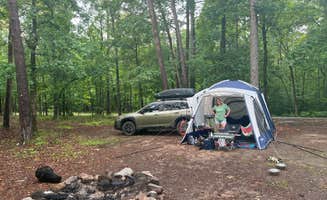Dispersed camping near Natural Bridge, Alabama offers several primitive options within the Bankhead National Forest region. Most sites lack standard facilities, requiring campers to be self-sufficient with water and waste management. The area sits at approximately 700-800 feet elevation with a humid subtropical climate that can create challenging conditions during summer months. Winter camping provides cooler temperatures but requires preparation for occasional freezing nights.
What to do
Hiking the Sipsey Wilderness: The area surrounding Wolf Pen Hunters Camp provides access to extensive trail networks. "This is a free hunters campground located in Sipsey wilderness. The hiking in this area is incredible and makes you feel like you are in another world," notes Asher K., who recommends checking hunting seasons before hiking to ensure visibility.
Stargazing opportunities: The minimal light pollution at Boondock Dispersed Camping Alabama creates ideal conditions for astronomy enthusiasts. "The stars were incredible after the moon went down a bit," reports Rae W., who visited during summer months. Campers should plan to stay at least one night to experience the night sky.
River access activities: Several campsites near TVA-Nature Trail and Recreation Area offer water-based recreation opportunities. Trinity W. discovered that "many of the side trails lead to the river. There is even a small beach area down the one that leads along the river to the old train bridge." Historical markers throughout the area provide context for both natural and man-made features.
What campers like
Elevated riverside views: The bluff settings at Blue Creek Public Use Area create natural vantage points. Ken H. describes it as a "Large area overlooking the river that gives you a slight breeze for 85 degrees in mid June," noting the concrete overlook viewing area above the river provides relief during hot weather.
Secluded forest settings: Many campers appreciate the isolation of sites despite proximity to roads. At Wolf Pen Hunters Camp, Sam O. found that "Sites are spread out and pretty private," while noting they were "level and clear" though "a little muddy" after rain. Most sites require no reservation and operate on a first-come basis.
Historical exploration: The TVA lands contain numerous historical markers and features. "This trail is rich in history, and there are a lot of plaques telling about certain natural and man-made features along the trails," reports Trinity W., who specifically recommends visiting the old train bridge as a highlight.
What you should know
Road conditions vary seasonally: Forest access roads deteriorate significantly after rainfall. Timothy K. at Wolf Pen Hunters Camp advises getting "there quick enough" to secure "some pretty good spots," suggesting competition for the limited number of usable sites during peak times.
Facilities are minimal or nonexistent: Most sites require complete self-sufficiency. Frits Z. describes Wolf Pen as "Heel leuk, zonder stroom, geen voorzieningen; terug naar de basic natuur" (Very nice, without electricity, no facilities; back to basic nature), emphasizing the primitive conditions.
Cell service varies by location: Some sites unexpectedly offer limited connectivity. Rae W. reported "Ended up having a little cell reception with T Mobile" at Boondock Dispersed Camping, though this shouldn't be relied upon throughout the region.
Tips for camping with families
Accessible recreation areas: Some primitive camping zones offer nearby facilities. At TVA-Nature Trail and Recreation Area, Trinity W. found "a nice well-kept, clean restroom building with flush toilets" and notes that "Behind that building, they recently put in a very nice playground and a pavilion with picnic tables," making it suitable for families needing occasional access to facilities.
Educational opportunities: Several areas feature interpretive signage about local ecology. Trinity W. mentions "small plaques around some of the plants telling what they are and a little about them," providing natural learning opportunities for children.
Multi-site availability: Groups requiring several adjacent sites have options. Rhea B. at Boondock notes three distinct camping areas along the access road, explaining "The second was perfect. We had to improve the fire ring a bit. Plenty of kindling around," indicating family groups can find appropriate accommodations.
Tips from RVers
Site selection for larger vehicles: Not all primitive sites accommodate RVs equally. At Blue Creek Public Use Area, Michael P. observed that "some folks also pull RV down to an area near the boat ramp," suggesting specific locations better suited for vehicle-based camping.
Turnaround availability: Forest roads often end with limited maneuvering space. Dwight L. describes Boondock's third site as "nestled in a nice culdesac area," indicating sufficient space for turning vehicles at this location, while the first two sites along the access road may present challenges for larger rigs.
Leveling requirements: Natural terrain requires preparation for comfortable camping. Adam D. describes Blue Creek as a "Nice big site" that "felt very private," though RVers should note the bluff-top location may require leveling equipment on the uneven ground.




